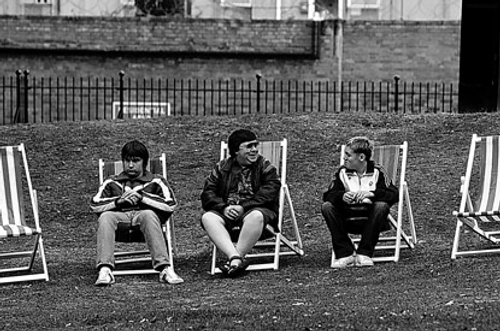The best image in Somers Town, shot in black and white, comes somewhere past halfway through the film, when Tomo (Thomas Turgoose) and Marek (Piotr Jagiello), have arrived at their favorite diner to find that the French waitress Maria (Elisa Lasowski), who they share a lustful affection for, has gone back to Paris for some time. They have wheeled their salvaged wheelchair all the way over, and decorated it with flowers and sparkling ribbons just for her, and the diner’s owner is just closing up when he tells them the news. They turn around after Tomo dismally remarks that it ‘…doesn’t matter anymore,’ and are pushing their sad wheelchair around the block as the manager pulls a lever that brings the metal garage door to the diner all the way closed. The motion of the door closing and the figures of the boys waddling down the sidewalk in teenage disappointment is the best merging of motion in the entire film, and makes the shot one of the better small moments in this film which relies on small moments to function.
Tomo is a boy from the Midlands who boards a train to London at the beginning of the film. We do not know and never find out precisely what home life he is trying to escape from, but we can be sure it was a sufficiently bad situation for Tomo to resort to travelling to the city with no money and the intention to steal and drink to get by. A sympathetic Scottish woman he meets on the train tries to help him out, but she disappears from the film with Tomo’s rejection of her offer to buy him a train ticket home. Tomo manages to nab a case of beer from a liquor store, but it is stolen by a group of punks who beat him up in the middle of the night. But just as Tomo’s story is starting to resemble a version of Naked for the pubescent teen set, he meets Marek. Marek is a Polish immigrant living with his construction worker father in a small flat somewhere in London. He loves photography, understands English well, but is still learning to read it; his father is a hardworking, hard-drinking macho character who is trying to escape a past of his own. The two meet entirely intentionally on the part of Tomo; he sits down next to Marek in the café they will return to again and again, and takes one his photos of Maria out of his hand. Tomo chides Marek, asking who the girl is, and a chase resulting in Tomo finally giving back the picture. The two soon become friendly with each other and make it their ultimate goal to woo Maria, who is the subject of many of Marek’s pictures.
Somers Town is casual and relaxing to watch, but casual here does not mean improvised. The film intercuts between Tomo’s wanderings and Marek’s home life in a very deliberate way to show the ways in which Tomo is homeless yet nationally at home, while with Marek it is the other way around. Visually, it follows the rules of Ozu’s cinema; keep the camera steady—with several notable exceptions—but don’t add any unnecessary elements in to the scene; keep the scenery controlled, but still realistic and not at all showy. Essentially, the scenery in Somers Town serves the characters. In one shot, for example, Marek and Tomo, shielded by vertical glass windows, are running up the stairs to Marek’s flat to get drunk and cause mayhem; a sign on the right says that children are prohibited from playing in the area. There are several variations on this shot later on, revealing Meadow’s and his DP, Natasha Braier, as crafty storytellers and rather matter-of-fact Ozu’s.
Yet the filmmakers should be faulted for some deliberateness that falls in to sentimentality. The use of a song by the singer Gavin Clark does not do the film any good, and mars one scene, which should have been beautiful in which Tomo and Marek push Maria home in the wheelchair. As they move through parks and across bridges, the scene comes to resemble something from a nostalgic (albeit well-done) video one is meant to watch at their High School graduation; it betrays the naturalistic sentiment of the rest of the film. The same song plays at the end, in a particularly suspect scene which finds the two boys in Paris and the film in color. We know they would end up in Paris, but do we need to see it? If the rest of the film relies on two people in limbo with only dim aspirations, should the film make the large jump from that stage to total gratification?
It seems inappropriate, but it still puts a smile on one’s face. One of its most basic goals being to put a smile on your face, Somers Town accomplishes this very well. Like last years superb English film Happy Go-Lucky, it pulls the despair of the older, realist British cinema in to the sunshine realm and comes up with a remarkable compromise. Could this be the start of another trend of English cinema? If it is, enjoy the smiles.